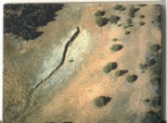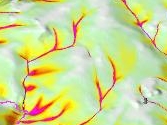|
 While soil erosion is a natural process, human activities such as
construction or vehicular disturbance can substantially increase the rates
of erosion, sediment transport and deposition. Increased erosion and
sedimentation can create hazardous conditions, destroy water quality and cause
other environmental damage, requiring costly repairs.
It is therefore important to minimize the
damage caused by disturbances by planning soil conservation measures.
Such planning may seem difficult for large areas but geographic information
systems (GIS) can provide
the tools to assess the erosion risk, evaluate various disturbance alternatives and
spatially optimize conservation measures.
While soil erosion is a natural process, human activities such as
construction or vehicular disturbance can substantially increase the rates
of erosion, sediment transport and deposition. Increased erosion and
sedimentation can create hazardous conditions, destroy water quality and cause
other environmental damage, requiring costly repairs.
It is therefore important to minimize the
damage caused by disturbances by planning soil conservation measures.
Such planning may seem difficult for large areas but geographic information
systems (GIS) can provide
the tools to assess the erosion risk, evaluate various disturbance alternatives and
spatially optimize conservation measures.
|
|
 This tutorial provides information on the preparation of data,
running selected erosion models in GIS, and viewing and analyzing the results.
While RUSLE3D and USPED models are the main focus of the tutorial, principles
of more complex models are covered also. The tutorial is also useful for
preparation of data and visualization of results from distributed hydrologic
and erosion models, which are not described here. Detailed summaries
of model implementation are provided for ESRI's ArcGIS and
the open source GIS GRASS, however, the principles that are presented
also apply to other raster based systems. This tutorial provides information on the preparation of data,
running selected erosion models in GIS, and viewing and analyzing the results.
While RUSLE3D and USPED models are the main focus of the tutorial, principles
of more complex models are covered also. The tutorial is also useful for
preparation of data and visualization of results from distributed hydrologic
and erosion models, which are not described here. Detailed summaries
of model implementation are provided for ESRI's ArcGIS and
the open source GIS GRASS, however, the principles that are presented
also apply to other raster based systems.
|